-
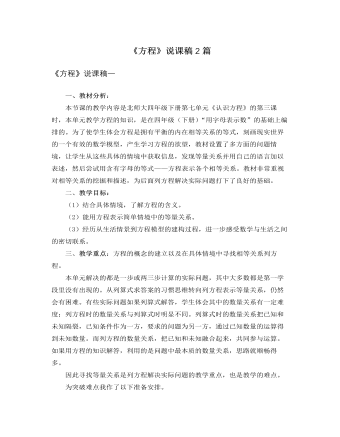
北师大版小学数学四年级下册《方程》说课稿2篇
3、变换角度,深入思考第三幅情境图隐含着多样的等量关系,也正是引发学生数学思考的最佳情境。根据学生认识的深入程度,可适当让学生体会到等式的“值等”和“意等”,并放手让学生探究,根据不同的认识找到不同的等量关系,列出等量关系不同的同解方程。在教学中,先引导孩子发现情境中的基本相等关系:2瓶水的水量+一杯水的水量=一壶水的水量,并且列出等式2z+200=2000,在此基础上,再引导孩子发现其他的等量关系。在这一过程中,充分激发孩子探求知识的欲望,调动孩子思考的主动性和灵活性,从而找到多样化的等量关系,并进一步提高孩子解决数学问题的能力。4、建立概念,判断巩固在前面教学的基础上总结、抽象出方程的含义。通过三道例题的简洁数学式子表达,让小组合作寻找他们的共同特点,从而建立方程的概念。“含有未知数”与“等式”是方程概念的两点最重要的内涵。并通过“练一练”让学生直接找出方程。
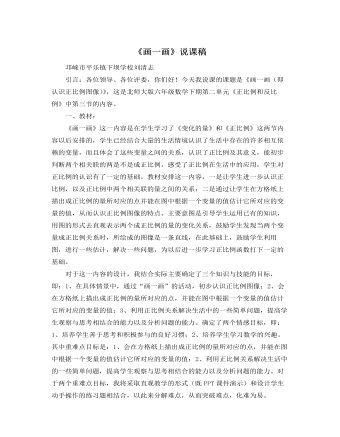
北师大版小学数学六年级下册《画一画》说课稿
一、教材:《画一画》这一内容是在学生学习了《变化的量》和《正比例》这两节内容以后安排的,学生已经结合大量的生活情境认识了生活中存在的许多相互依赖的变量,而且体会了这些变量之间的关系,认识了正比例及其意义,能初步判断两个相关联的两是不是成正比例,感受了正比例在生活中的应用,学生对正比例的认识有了一定的基础。教材安排这一内容,一是让学生进一步认识正比例,以及正比例中两个相关联的量之间的关系;二是通过让学生在方格纸上描出成正比例的量所对应的点并能在图中根据一个变量的值估计它所对应的变量的值,从而认识正比例图像的特点。主要意图是引导学生运用已有的知识,用图的形式去直观表示两个成正比例的量的变化关系,鼓励学生发现当两个变量成正比例关系时,所绘成的图像是一条直线,在此基础上,鼓励学生利用图,进行一些估计,解决一些问题,为以后进一步学习正比例函数打下一定的基础。

人教版高中英语必修1English around the world说课稿
(3)v. 给:提出;展现,显现present sb. with sth. ; present sth. to sb. 把. . 交给;颁发;授予present sth. (for sth. )/present sth. to sb. e. g. Om his birthday, his friends presented him a collection of stamps. 在他生日时,他的朋友们送给他一套邮票作为礼物。The sword was presented by the family to the museum. 这家人把宝剑捐赠给了博物馆。The committee will present the final report to Parliament in June. 委员会将在六月向议会提交最后的报告。You need to present yourself better. 你需要更善于展现自己。It is essential that we present a united front. 至关重要的是我们要表现得更加团结。Step 4 ConsolidationT:Now that we have got a general idea of these words and phrases. Lets make up some sentences using them to master them. Suggested sentences:1. Your duties include typing letters and answering the telephone. 2. It is one of the greatest roles that she has played. 3. A large number of people have applied for the job. 4. The number of the panda is declining. 5. I'11 go there, even if I have to walk. 6. He came up to me to ask for a light. 7. The novel is about a family who can't communicate with each other. 8. He based his plan on interests of most people. 9. Why doesn't he make use of his singing talent?Step 5 Summary and homeworkT:Today we dealt with several new words and phrases. After class I hope that youcan read them again and again to keep them in mind. That's all for today. You aredismissed.

人教版高中英语必修3Astronomy the science of the stars说课稿3篇
Step 2 Pre-listeningAfter students finish their discussion, I will show a picture of Newton and ask them: Who is him? What is he famous for? Could you find out some words to describe him? Maybe students will answer that he is genius for his finding of theGravitation, making a great contribution to the progress of human being. At that time I will show another two pictures of Einstein and Hawking, letting students guess who they are and write down their idea about the Gravitation. For I have arranged them to search more information about the gravity before this class, Students have beenfamiliar with the topic and will not be afraid about this abstract conception, which is helpful for their listening.Step 3 While-listeningIn this step, students will be required to listen the material for three times. The first and listening is extensive listening and the second and third listening is intensive listening. In the first time, They are required to listen a material including Part 1 and Part 2 and choose the best summary of the listening text. After they choose the right answer, They also need work in group to explain what is wrong with the others. Then I will make a conclusion that we should pay attention to the first paragraph and last paragraph and some keys to get the main idea. By doing this, their capacity of generalization will have a great improvement.Before the second listening, I will ask students to scan the blank on the power point quickly and ask them to note down some key words .Then ask them to listen to the Part 1again and fill the first column of the chart. Maybe some students just show the ideas of these three scientists an still can’t catch their development of gravity. Therefore, I will ask them to listen to Part 2 again and fill in the rest. After finish the listening, I will give them ten minutes to discuss with their partner. I will also guidethem to improve their answers when they discuss with others.

人教版高中英语必修3Canada-the true north说课稿4篇
Good afternoon, teachers, It’s my great pleasure to be here sharing my lesson with you.The content of my lesson is Senior English Book 3 Unit 5 Canada —— “The true North”.I’ll be ready to begin this lesson from five parts. Analysis of the teaching material,the teaching methods,the studying methods, the teaching procedure,and Blackboard design.First, let me talk about the teaching material.Part 1 Teaching Material:This unit is about the introduction of Canada. By studying of this unit,we’ll enable the students to learn the geography, population, main cities, and natural beauty, natural resources of Canada. Through the training of the unit, it also requires students to learn some Language skills such as the expressions of position and emotions.So it plays an important part in the English teaching in this book.After studying the teaching material and analyzing the rule of children’s growing of mind,I think the teaching aims are the followings:1.Knowledge objects:(1) make the students learn some new words and phrases(2) make the students understand the content of the lesson.2.Ability objects:(1)To develop the Ss’ abilities of listening, speaking, reading and writing. Especially reading and speaking ability.(2) learn to talk about the characters of Canada in English(3)To train the Ss’ ability of working in pairs.3.Emotion objects:(1)Enable students to understand the characters of Canada..(2)Stimulate Ss to work hard to make China stronger.Part 2 Teaching Methods:I think helping students learn to master new words and phrases and improve the students’ reading and speaking ability is import and the difficult.According to the analysis of the teaching material and the import points and the difficult points,I will use the following teaching methods : question-guiding approach; fast-reading and careful reading; multi-media teaching methods; discussion

人教版高中英语必修4Theme parks说课稿3篇
The oldest and the most popular park in the worldenjoy the exciting activities thereget close to the life-size cartoon characters like Mickey Mouse and Donald Duck Step 3 Pre-reading1.What do you suppose a theme park is ?2.What do you think you can see in a theme park?(1.It is a kind of amusement park which has a certain theme – that the whole park is based on. 2.buildings, castles, statues, rare animals and birds, and so on.) Step 4 Reading ----- Theme Parks –---- Fun and More Than Fun1.Predict : Read the title and the pictures on P. 34 and PredictWhat is the meaning of the title “Theme Park – Fun and more than fun”?(The title means that theme parks are fun to visit, but that they can also be educational and can offer useful information.)2.Skimming Fast read and answer:What activities can we take in a theme park?Amusement park: Bumper car Merry-go-round slide bungee jumping Free-fall rides Horror films Pirate ship Ferris wheel roller coaster3.Scanning Read again and you will find various theme parks are mentioned in the passage . Then what are they ?Theme parks: Sports theme park History theme park Culture theme park Marine or Ocean theme Park Future park Science theme park Disneyland4.Careful reading and find the main idea of each paragraph:THEME PARKS---- entertaining/ educationalPara.1 Traditional parks are places to go for relaxation and to have time away from our busy lives.Para.2 Theme parks are different They’re large and full of things to do, see and buy.Para.3 Theme parks are built around a single idea or theme. One example is a sports park.Para.4 Another kind of theme park is historical more and cultural and can be educational.Para.5 Disneylandwas the first theme park. It is based on the fantasy life and characters of Disney’s films.Para.6 Some examples of educational theme parks include sea world parks and science parks.

人教版高中英语必修3The million pound bank note说课稿3篇
在接下来的细读环节,我套用了高考对阅读理解的考查方式设置了5个问题,分别为三个推理判断题,一个细节题和一个主旨大意题。学生需要对文章的内容进行分析、归纳、推理、猜测等高级思维活动才能做出正确的回答。【设计意图】这一过程是对学生进行细读的训练,培养学生获取特定信息和挖掘文章深层次信息的能力。第三环节:Intensive-reading (精读) 15′第三个环节精读,既是最重要的环节,也是突破本课重难点的关键。首先,让学生思考剧本中人物看到百万英镑前后的态度发生了怎样的变化。其次,让学生仔细阅读文章,找出可以表现人物态度变化的具体的语言和动作。最后,让学生总结人物的态度发生变化的根本原因是什么,从而引出Money Talks, 供学生思考。【设计意图】通过一系列的活动培养学生学习从人物的语言和动作探究人物的心理,使学生进一步体会戏剧语言的魅力,从而对文章背后所反映的社会问题进行思考,也为下一步的讨论环节做好铺垫。

人教版高中英语必修5Life in the Future说课稿5篇
Good afternoon, everyone. It’s my great pleasure to be here sharing my lesson with you. The content of my lesson is Senior English for China Book5 Unit 3 Life in the Future. I’ll be ready to begin this lesson from six parts: Analysis of the teaching material, Analysis of the students, Teaching aims and important and difficult points, Teaching methods and aids, Teaching procedures, and Blackboard design. First, let me talk about the teaching material.Part 1 Analysis of the Teaching Material:This unit is about what human beings’ life will be like in about one thousand years. By studying of this unit, we’ll Enable the students to know the changes in humans’ life and some new inventions bringing about the change and develop the interest in science. This lesson plays an important part in the English teaching in this unit. This is an important lesson in Book Five. From this lesson, it starts asking the Ss to grasp contents of each passage. Therefore, this lesson is in the important position of the teaching material. If the Ss can learn it well, it will be helpful to make the Ss learn the rest of this unit.Part 2 Analysis of the SsAs Senior2 Ss, they are at different levels of English fluency, some of them have lost interest in English. So during the lesson, I arrange a variety of activities to let all of them join in to attract their interest and let them be confident and taste the joy of success.
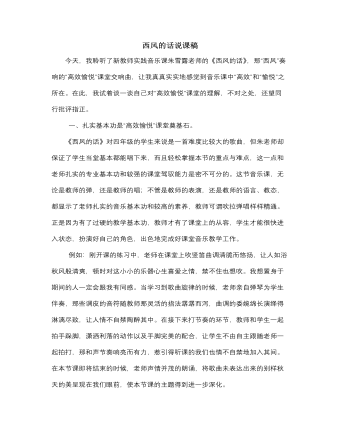
人音版小学音乐四年级下册西风的话说课稿
课堂上随机给出鼓励和肯定的语言更显教师的亲和力,营造出一个自由、民主的课堂教学氛围。如:“你很棒”“说得太好了”“掌声鼓励”等等,听似平淡无奇,但结合那时那景则显得老师语言的朴实与自然,学生同老师间的默契与和谐。听完朱老师执教的《西风的话》一课,通过认真反思我真切认识到:一堂好课是否愉悦高效,就看教师是否真正用心的地去诠释作品,真正用心地去备课。孙老师执教的《西风的话》平实、淡雅,教师教态自然大气,言谈中充满着激情,让我们的心不自觉跟着一起走。我想不出什么华丽的词藻来描述这堂课,但我却深深地被吸引,这应该就是生命课堂的魅力所在吧。听了孙老师执教的《西风的话》后收获很多,能于言表的也还没有表达充分,但更多的是带给我的触动和对自己所教学科如何“高效愉悦”的思索。也希望凭借着“高效愉悦”课堂活动的深入开展,让自己的美术课堂灵动起来,让我们的课堂真正成为孩子们探求知识的乐园。
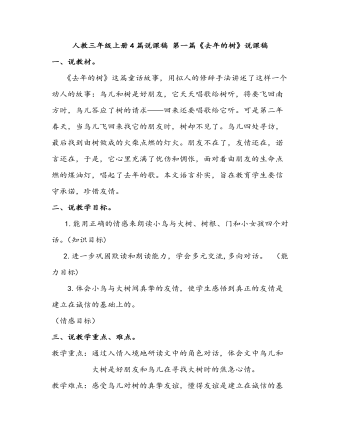
人教版三年级上册语文说课稿
二、说教学目标。 1.能用正确的情感来朗读小鸟与大树、树根、门和小女孩四个对话。(知识目标) 2.进一步巩固默读和朗读能力,学会多元交流,多向对话。 (能力目标) 3.体会小鸟与大树间真挚的友情,使学生感悟到真正的友情是建立在诚信的基础上的。
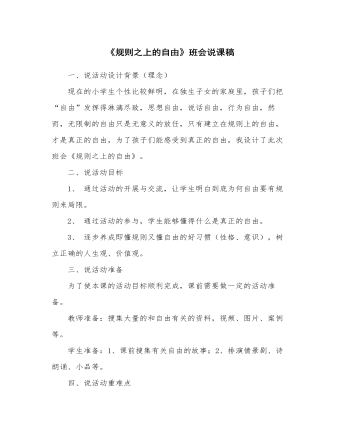
《规则之上的自由》班会说课稿
1、 通过活动的开展与交流,让学生明白到底为何自由要有规则来局限。2、 通过活动的参与,学生能够懂得什么是真正的自由。3、 逐步养成即懂规则又懂自由的好习惯(性格、意识),树立正确的人生观、价值观。三、说活动准备为了使本课的活动目标顺利完成,课前需要做一定的活动准备。教师准备:搜集大量的和自由有关的资料,视频、图片、案例等。学生准备:1、课前搜集有关自由的故事;2、排演情景剧、诗朗诵、小品等。四、说活动重难点重点:让学生理解(感受)到规则之上的自由的重要性。难点:让学生学以致用,自由观念深入人心。五、说活动方法根据本节课的具体内容,结合小学生具有的心理特点,我采用了讲述法、课堂讨论法、学生互动交流、表演节目、举例子等方法。学生主要采用“自主、合作、探究”的探究方法,充分地调动小学生参与活动的积极性,达到预期的教育目的。

小学美术人教版四年级上册《第7课今天我值日》教学设计说课稿
一、谈话导入:师:咱们班今天是谁的值日生啊?学生反馈(教师请值日的学生回答并根据班级卫生情况做出简单评价或表扬。)师:今天的值日生表现非常棒,值日工作做的很好,希望其他同学向他(她)学习。那你们想不想把我们值日时的场面画在纸上呢?今天就让我们来学习第七课《今天我值日》。(打开课件)生:学生打开课本第七课《今天我值日》。
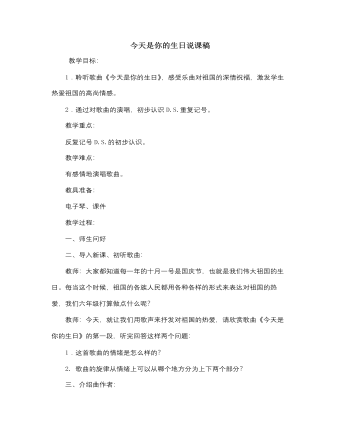
人音版小学音乐六年级上册今天是你的生日说课稿
教师:D.C.是从记号处反复,那么D.S.呢?D.S.是从头反复,到英文Fine结束。二者要区分开来,下次我们遇到再仔细讲。教师:最后我们完整的演唱一遍这首歌曲,同学们的歌唱状态准备好了吗?怎么坐的?教师:同学们演唱的真不错,从歌声里啊就能感受到同学们对祖国的热爱,对祖国未来的祝福之情。我对同学们的欣赏之情啊,犹如黄河泛滥,一发不可收拾。八、预备拓展方案:1. 这首歌曲对仗工整,相同点多,让学生模仿歌词自己编写歌词,然后演唱。2. 设计轮唱演唱形式。九、课堂小结:同学们,今天这堂课,同学们很积极,用深情地歌声表达出对伟大祖国生日的祝福,同时我们也新学了一个音乐当中的知识点:D.S.从记号处反复记号。这堂课,老师很高兴,送给在座的你们一句话:少年智,则国智;少年强,则国强;今天的课就上到这里,下课(播放音乐,学生走出教室。)
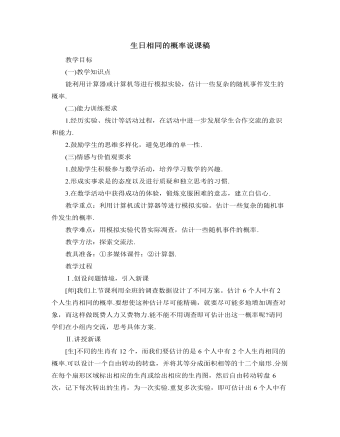
北师大版初中数学九年级上册生日相同的概率说课稿
Ⅵ.活动与探究某种“15选5”的彩票的获奖号码是从1~15这15个数字小选择5个数字(可以重复),若彩民所选择的5个数字恰与获奖号码相同,即可获得特等奖.小明观察了最近100期获奖号码,发现其中竟有51期有重号(同一期获奖号码有2个或2个以上的数字相同),66期有连号(同一期获奖号码中有2个或2个以上的数字相邻).他认为获奖号码不应该有这么多重号和连号,获奖号码可能不是随机产生的,有失公允.小明的观点有道理吗?重号的概率大约是多少?利用计算器模拟实验可以估计重号的概率.[过程]两人组成一个小组,利用计算器产生1~15之间的随机数.并记录下来,每产生5个随机数为一次实验,每组做10次实验,看看有几次重号和连号.将全班的数据汇总集中起来,就可估计出1~15之间的整数中随机抽出5个数出现重号和连号的概率.
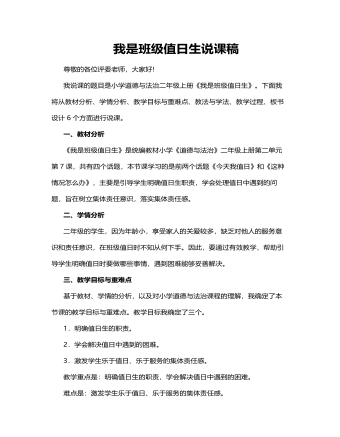
人教部编版道德与法制二年级上册我是班级值日生说课稿
学生阅读教材第26页的四幅图画,反思日常生活中自己的一些做法,然后在小组内交流,再全班交流展示,教师相机引导、板书。设计意图:对日常生活中自己值日的思考,激发学生对值日生职责的认同感。活动二:解决值日中遇到的难题学生阅读教材第27页的四幅图,思考自己在值日中遇到过什么困难,然后全班交流,学生畅所欲言,教师引导学生共同解决。设计意图:针对学生值日中真实的困惑进行引导和解决,提高学生的责任意识、道德能力。活动三:我是今天的值日生课件出示儿歌《我是今天的值日生》。学生先自己读一读,全班再齐读。设计意图:再次认识值日生的职责。环节三:课堂小结,内化提升学生谈一谈学习本节课的收获,教师相机引导。设计意图:梳理总结,体验收获与成功的喜悦,内化提升学生的认识与情感。环节四:回归生活,拓展延伸制作班级值日生的表格,记录自己今后做值日的情况。设计意图:将课堂所学延伸到学生的日常生活中,有利于落实行为实践。
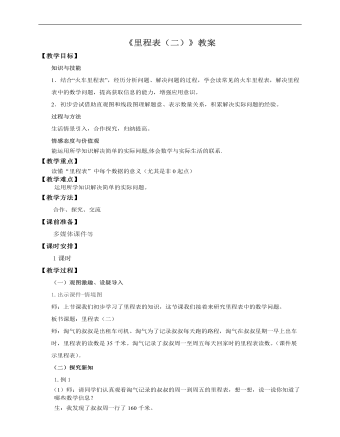
小学数学北师大版三年级上册《第五课里程表(二)》教案说课稿
(一)观图激趣、设疑导入 1.出示课件-情境图师:上节课我们初步学习了里程表的知识,这节课我们接着来研究里程表中的数学问题。板书课题:里程表(二)师:淘气的叔叔是出租车司机。淘气为了记录叔叔每天跑的路程,淘气在叔叔星期一早上出车时,里程表的读数是35千米。淘气记录了叔叔周一至周五每天回家时的里程表读数。(课件展示里程表)。(二)探究新知1.例1(1)师:请同学们认真观看淘气记录的叔叔的周一到周五的里程表,想一想,说一说你知道了哪些数学信息?生:我发现了叔叔周一行了160千米。 师:同学们他说找到数学信息对吗?生:160千米不是星期一的行驶里程,应该是星期一晚上里程表上的读数。 星期二里程表上的读数是350,。生:。。。。师:同学们找的数学信息非常多,非常全面。(2)小组讨论交流:淘气根据题意画了一个图,你看懂了吗?与同伴说一说。
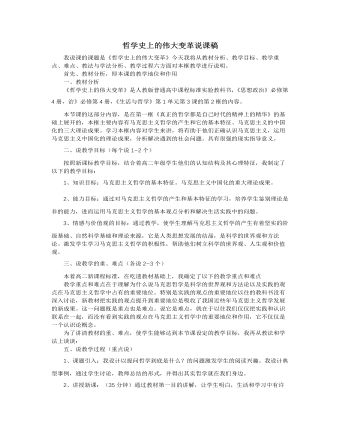
人教版高中政治必修4哲学史上的伟大变革说课稿(一)
2、讲授新课:(35分钟)通过教材第一目的讲解,让学生明白,生活和学习中有许多蕴涵哲学道理的故事,表明哲学并不神秘总结并过渡:生活也离不开哲学,哲学可以是我正确看待自然、人生、和社会的发展,从而指导人们正确的认识和改造世界。整个过程将伴随着多媒体影像资料和生生对话讨论以提高学生的积极性。3、课堂反馈,知识迁移。最后对本科课进行小结,巩固重点难点,将本课的哲学知识迁移到与生活相关的例子,实现对知识的升华以及学生的再次创新;可使学生更深刻地理解重点和难点,为下一框学习做好准备。4、板书设计我采用直观板书的方法,对本课的知识网络在多媒体上进行展示。尽可能的简洁,清晰。使学生对知识框架一目了然,帮助学生构建本课的知识结构。5、布置作业我会留适当的自测题及教学案例让同学们做课后练习和思考,检验学生对本课重点的掌握以及对难点的理解。并及时反馈。对学生在理解中仍有困难的知识点,我会在以后的教学中予以疏导。
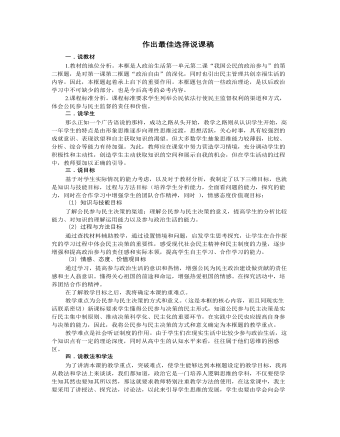
人教版高中政治必修2作出最佳选择说课稿
环节四 模拟演练 情感升华我将让同学们阅读课本22页的材料,并按照所提供的步骤,组织学生举办一次模拟听证会,将学生分为四个小组,分别扮演教育局工作人员、人大代表、学生家长、学校校长的角色。待学生们模拟听证会结束后,我将采访学生,让他们谈谈参加完听证会后的感受,从而利用角色感悟总结落实民主决策的重大意义。这样,学生们在模拟演练中,感悟公民要通过各种渠道参与民主决策,是推进决策科学化、民主化的重要环节。为学生将来参与政治生活积累经验,增强了学生的主人翁意识和社会责任感。环节五 课堂小结 课后延伸我将用多媒体展示本节课的知识框架,并注重引导学生将今天所学新知识与前面知识联系起来,帮助学生从宏观上把握各知识点之间的关系,有利于学生理解记忆。另外,适当的课堂练习能检验学生掌握知识的情况,因此,课堂小结后我将让学生做一些典型的练习,加深学生对本课知识的理解,同时为为下一课的学习做准备。
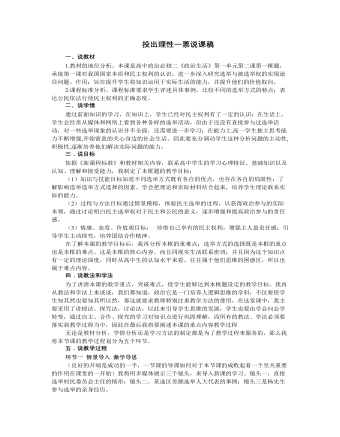
人教版高中政治必修2投出理性一票说课稿
环节三情景模拟 情感升华首先:1、本课开始观看的视频中:选出村长体现了村民参加选举的什么态度?生活中一些人“多我一票不多,少我一票不少,选举与我无关"的想法2、你如何看待上述两种不同态度?为什么?发表你的看法【教师这个过程中点拨、引导】如果我们都不珍惜自己的选举权,那么我们的国家将会出现什么后果?3、那么作为将来选民和被选举人,你们认为应具有那些政治素养才能适应?学生结合教材思考(1)(提示)不行使或不认真行使自己的选举权,意味着我们将不能选举出能为人民谋福利的当家人,意味着我们的国家将由重蹈旧中国的覆辙。(2)从态度上讲:公民应积极参加选举,认真行使这一权利,不断增强公民意识和主人翁意识,增强公民的参与感和责任感。(3)从能力上讲:要不断提高公民的政治参与能力(政治素质、文化素质、议政能力),在周全考虑、理性判断的基础上,郑重地投出自己的一票。
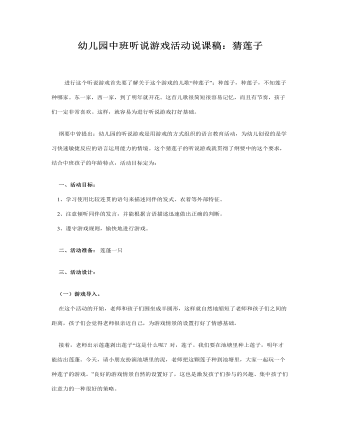
幼儿园中班听说游戏活动说课稿:猜莲子
一、活动目标: 1、学习使用比较连贯的语句来描述同伴的发式、衣着等外部特征。 2、注意倾听同伴的发言,并能根据言语描述迅速做出正确的判断。 3、遵守游戏规则,愉快地进行游戏。 二、活动准备: 莲蓬一只 三、活动设计: (一)游戏导入。 在这个活动的开始,老师和孩子们围坐成半圆形,这样就自然地缩短了老师和孩子们之间的距离,孩子们会觉得老师很亲近自己,为游戏情景的设置打好了情感基础。 接着,老师出示莲蓬剥出莲子“这是什么呢?对,莲子。我们要在池塘里种上莲子,明年才能结出莲蓬。今天,请小朋友扮演池塘里的泥,老师把这颗莲子种到池塘里,大家一起玩一个种莲子的游戏。”良好的游戏情景自然的设置好了,这也是激发孩子们参与的兴趣、集中孩子们注意力的一种很好的策略。